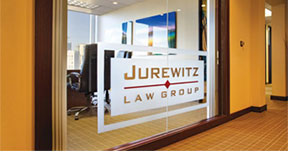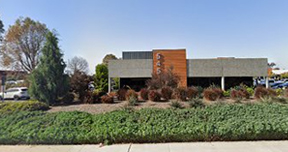Fall Injury on a Broken or Dangerous Staircase
Stairways are inherently dangerous places that can cause serious injuries to even the most surefooted individual. The National Safety Council (NSC) reports that more than one million Americans are injured or killed every year in staircase accidents. Stairway accidents usually result in such moderate to severe injuries as cuts‚ abrasions‚ and contusions (bruises); sprained tendons‚ ligaments‚ and muscles; broken and crushed bones; neck‚ back‚ and shoulder injuries; head trauma; and broken teeth. If you have been injured or lost a loved one in a staircase accident‚ you may have grounds for a personal injury or wrongful death claim.
To find out more about your legal rights and options‚ you’ll need to consult an experienced San Diego slip and fall injury attorney. Jurewitz Law Group Injury & Accident Lawyers has been successfully representing Southern California injury victims since the year 2000‚ consistently winning substantial settlements for their clients. Call Jurewitz Law Group Injury & Accident Lawyers today at (855) 549-6817 to schedule a free consultation.
Common Causes of Stairway Accidents
The following are some of the more common causes of stairway accidents that involve negligence on the part of the property’s owner:
- Slippery surfaces: When the carpeting or wood surface of a staircase gets too worn down‚ the steps can become slippery. The property’s owner is responsible for keeping the stairway safe by replacing the carpeting or replacing the boards of the steps. Some stairs may be made of tile‚ highly polished wood‚ or stone that is naturally very slippery. The property owner in such a case may have chosen appearance over safety‚ which does not excuse them from liability.
- Icy or wet stairs: Outside stairways must be designed and maintained so that excessive water‚ snow‚ or ice does not collect on them. The property owner also has an obligation to keep their stairs shoveled during the winter and to put salt or sand on them to make them less slippery.
- Debris on stairs: A property owner has an obligation to keep stairways free of debris and other obstructions which may cause someone to trip and fall.
- Building code violations: Every municipality has building codes that specify what dimensions the vertical (“riser”) and the horizontal (“run”) of steps must be. Not having the stairs meet those specifications can be seen as negligence. Building codes also specify that steps must be consistent in the dimensions of the risers and runs‚ so as not to confuse someone using the stairs. Lastly, ‚ building codes are specific about the size and placement hand railings. Having railings that are too high‚ too low‚ or too weak is a violation of building codes.
- Poor lighting and maintenance: Stairways need to be adequately lit and maintained. Crumbling steps or deteriorating boards need to be replaced.
- Lack of handrails: A staircase can be unreasonably dangerous when it does not offer a level of support to anyone descending or ascending a staircase. A property owner may be liable for failure to install a handrail or installing a defective handrail.
No matter the specific cause of a stairway accident, seek medical attention. You should go to obtain an evaluation from a healthcare professional even when you do not think you were hurt. Many injuries can have delayed symptoms, and you will face a more difficult time recovering money damages when there is any delay in treatment.
If possible, try and take as many pictures as you can of the dangerous staircase right after the accident. Photographs and/or videos can be valuable evidence especially before a property owner fixes the problem or circumstances change.
Frequently Asked Questions (FAQs) About Stairway Accidents
When you are going through the process of finding a San Diego staircase accident lawyer to handle your personal injury claim, you probably have questions. It is important to be selective about your lawyer to get the best possible result. Jurewitz Law Group Injury & Accident Lawyers stands ready to address your questions and concerns. Read over some of our frequently asked questions and contact us to schedule an appointment for a free case evaluation. Also, check out our client testimonials page.
Who is liable for a stairway accident in San Diego?
Liability for a staircase accident can vary depending on the specific incident. Staircase accidents are often a form of “premises liability‚” meaning the owner of the premises is ultimately responsible for keeping the location safe. In other cases, multiple parties may bear liability for an accident, including renters and maintenance companies, among others. An experienced staircase accident attorney can conduct a thorough investigation and, in so doing, identify all the responsible parties.
How long do you prove that a property owner “should have known” about a staircase defect?
A defect is a hazard about which a property owner should have been aware when the conditions were apparent and unchanged for a period of time. Many property owners try to avoid premises liability claims by arguing that they had no idea a staircase was dangerous. An experienced attorney can thoroughly review the evidence and secure proof that a defect or hazard had existed long before an accident. A court may agree that a property owner should have known about a dangerous condition if a reasonable person would have discovered it.
How long do I have to file a lawsuit for a stairway accident in San Diego?
Under California Code of Civil Procedure §335.1, a lawsuit for injury to, or for the death of, an individual caused by the wrongful act or neglect of another must be filed in court within two years of the date of an accident. Certain exceptions do apply, however. When an injury is not immediately discovered, an accident victim has one year from the date of the discovery of an injury to file suit. Cases against governmental entities also require lawsuits to be filed within one year or possibly six months in some instances. There are other possible, limited exceptions to the statute of limitations but never assume they will apply to your case. Instead, retain counsel as soon as you can after a staircase accident to avoid missing any legal deadlines.
What damages could I be entitled to?
Money damages in a staircase accident case can vary depending on the specific facts of the case. Many stairway accidents in San Diego are ultimately resolved through settlements because the insurance companies handling these claims simply do not want to run up legal fees. For this reason, settlements that seem out of reach after extensive negotiations are sometimes agreed to on the eve of a trial.
Whether at the settlement table or in the courtroom, you can count on the entire community-oriented team at Jurewitz Law Group Injury & Accident Lawyers to seek a full range of compensation for you and your family.
When a staircase accident does go to court, a victim who wins could receive compensatory damages, including economic and noneconomic damages. Economic damages refer to actual costs that can be proven and calculated; noneconomic damages are more subjective and relate to harm that is more emotional or psychological in nature. Common damages include:
- Medical expenses
- Lost wages
- Property damage
- Pain and suffering
- Loss of consortium
- Emotional distress
California does also allow a jury to award punitive damages when a plaintiff, i.e., the staircase accident victim, proves by clear and convincing evidence that a defendant’s conduct involved malice, oppression, or fraud. Such awards are relatively rare and difficult to prove in staircase accident cases.
What needs to be proven to recover damages?
When you do end up having to file a lawsuit over a San Diego stairway accident, you are going to have to prove a defendant’s negligence by a preponderance of the evidence. A preponderance of the evidence in a civil case is a far lower burden of proof than the standard of beyond a reasonable doubt used in a criminal case.
In general, a preponderance of the evidence effectively means that an accident victim claim is more likely to be true than not, even tipping the scales by as little as 51 percent.
The general requirement in a staircase accident case is that a defendant – i.e., the person or business being sued — owned or was otherwise responsible for a stairway, the defendant was negligent in their care for the stairway, the victim suffered injuries because of the defective stairway, and those injuries resulted in damages.
Stairway Accidents: How Often Do They Occur?
According to Reuters, a recent study in the American Journal of Emergency Medicine showed that more than one million Americans are injured on stairs annually. The study found that direct and indirect costs of non-fatal stair injuries totaled approximately $92 billion a year.
National Electronic Injury Surveillance System data on injuries involving stairs between 1990 and 2012 showed almost 25 million people received treatment in emergency rooms during that 23-year period. This translated to an average rate of approximately 38 stair-related injuries per 10,000 U.S. residents every year, or around 3,000 injuries a day and one injury every 30 seconds.
The study indicated that injury rates decreased 13 percent between 1990 and 1996 but then increased 24 percent between 1996 and 2012. Over 60 percent of these injuries occurred in homes, and approximately 62 percent of the victims were women.
The highest injury rates were reported for adults over 85 years of age, children under age three, and young adults in their 20s. More than two-thirds of emergency department visitors were between 11 years of age and 60 years of age.
The Occupational Safety and Health Administration (OSHA) reported that there were 39 different injuries or deaths caused by stairway accidents in 2018. There were 68 injuries or deaths caused by stairway accidents in 2017 and only 10 in 2016.
“An analysis of occupational stair accident patterns” published in the Journal of Safety Research found that 636 of the 688 cases in which the direction of travel on a staircase was indicated involved workers descending stairs and 92 percent of the injuries studied.
The Canadian BC Injury Research & Prevention Unit reported that in older adults, the hip, leg, and foot represented 43 percent of injured body parts, followed by the head and neck (21 percent), the shoulder, arm, or hand (18 percent), the trunk (16 percent), and other or missing (2 percent).
In young children up to age four, the head and neck represented 64 percent of injured body parts, the shoulder, arm, and hand represented 16 percent, and the hip, leg, and foot accounted for 15 percent.
According to the Injury Research & Prevention Unit, young children up to 4 years of age were most frequently involved in playing, running, jumping, or crawling activities at the time of their staircase accidents. Another 14 percent were being held, carried, or in strollers, seven percent were trips, slips, or stumbles, five percent involved unsecured gates or barriers, four percent involved wheeled toys or baby walkers, and 32 percent were classified as other.
Premises Liability and Staircase Falls in San Diego
Premises liability is a legal concept that maintains that the owner or possessor of a property has a duty of care (obligation) to keep that property “reasonably safe.” Failure to do so is negligence and the owner or possessor of the property can be held liable for any injuries that occur due to that negligence.
If you have been injured or lost a loved one in a stairway accident‚ you need to hire a dedicated premises liability lawyer in San Diego. For over 15 years‚ San Diego’s own Jurewitz Law Group Injury & Accident Lawyers has helped Southern California injury victims and their families get compensation for such things as medical bills‚ pain and suffering‚ lost wages‚ wrongful death‚ and more. Call our offices today for a free consultation at (855) 549-6817.


